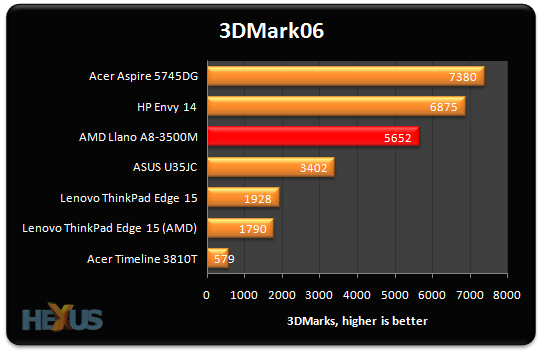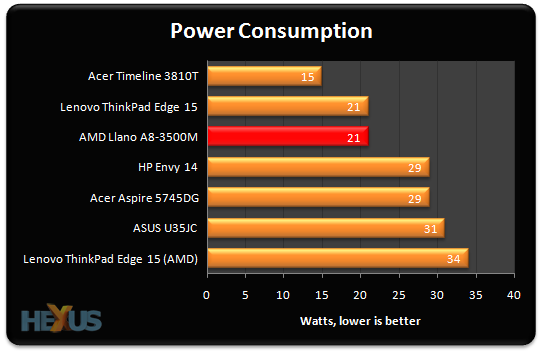All-round performance

Geekbench is an all-round test that provides an at-a-glance metric that's reasonably indicative of overall system performance.
The A8-3500M's quad-core CPU is certainly quicker than the triple-core chip in the ThinkPad Edge 15. Taken as a complete system the Intel laptops are reckoned to be a bit quicker.

Focussing in on the CPU part of the chips, the multi-threaded CINEBENCH test takes as many cores as you can throw at it. The same story persists here, that is, the A8's quad-core processing can't match performance from Intel's previous-generation Core i3 and Core i5.

It pays to take another look at the system table on the previous page. The Acer Timeline and Lenovo ThinkPad Edge 15 (Intel) both use integrated graphics. The rest grab a discrete mobile video card on top of any IGP that may be present.
What's impressive here is that we're looking at the performance of the APU's Radeon HD 6620G graphics on the Llano machine, rather than on the discrete card's (that's coming up). The benchmark shows the APU to be about 20 per cent slower than a discrete Radeon HD 5650 1GB card found in the HP Envy notebook.

Put in balanced mode and evaluated from the mains once a 720p trailer is running, the Llano laptop is pretty competitive on this front.

Run the test again but this time via the battery and in balanced mode and Llano's advanced power-management features and third-generation UVD block come out to play.
But we're doing the Llano laptop a disservice here because it can comfortably run the 720p looping clip on the power-saving state. Doing so increases time to hibernation to 307 minutes, or over five hours.
Multimedia, Blu-ray, and HTML5
The UVD 3.0 block takes practically all multimedia files in its stride. Understanding that AMD reckons its power-gating technology is granular enough to power down parts of the chip that aren't being actively used, we wondered if set to power-saving mode the sample laptop, running video off the UVD block, could play a lengthy Blu-ray movie from a single charge.
Throwing the excellent Inception Blu-ray disc into the drive and toggling the screen brightness to 50 per cent, the laptop was set to play back, via PowerDVD 11, the complete 2hr 28m. It completed the job with an estimated 58 minutes of juice left, intimating that it should be able to play practically every film on the market.
Hardware acceleration for new web protocols is becoming increasingly important. Running the Fishbowl benchmark on Internet Explorer 9 returned a score of 250 fish at 60fps when plugged in (high-performance mode) falling to 22fps on power-saving battery setting. The scores indicate above-average performance from an APU.









